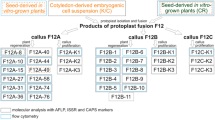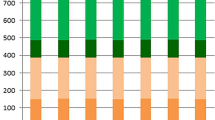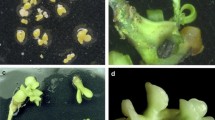Abstract
Somatic hybrids were obtained by the symmetric fusion of embryogenic callus cells from tetraploid ‘Mame’ kumquat [Fortunella hindsii (Champ.) Swing.] and mesophyll cells from diploid trifoliate orange [Poncirus trifoliata (L.) Raf.]. Southern blot analysis of three regenerants revealed that they carried specific rDNA fragments from both fusion partners, thereby confirming their hybridity. In contrast, mitochondrial DNA (mtDNA) and chloroblast DNA (cpDNA) were unidirectionally transmitted from the callus parent without any evidence of recombination. No differences in the restriction fragment patterns of rDNA, mtDNA or cpDNA could be detected among the regenerants. Flow cytometry showed that two regenerants were hexaploids, as expected, but that one was pentaploid, probably due to elimination of chromosomes prior to the regeneration of this plant.
Similar content being viewed by others
Abbreviations
- MS :
-
Murashige and Skoog (1962)
- DIG :
-
digoxigenin
- AMPPD :
-
3-(2′-spiroadamantane)-4-methoxy-4-(3″-phosphoryloxy)-phenyl-1,2-dioxetane
- FACS :
-
fluorescence-activated cell sorter
References
Arumuganathan K, Earle ED (1991) Nuclear DNA content of some important plant species. Plant Mol Biol Rep 9:208–218
Bennett M, Leitch IJ (1995) Nuclear DNA amounts in angiosperms. Ann Bot 76:113–176
Chaput M-H, Sihachakr D, Ducreux G, Marie D, Barghi N (1990) Somatic hybrid plants produced by electrofusion between dihaploidpotatoes: BF15 (H1), Aminca (H6) and Cardinal (H3). Plant Cell Rep 9:411–414
Dellaporta SL, Wood J, Hicks JB (1983) A plant DNA minipreparation: version II. Plant Mol Biol Rep 1:19–21
Frost HB (1938) The genetics and cytology ofCitrus. Curr Sci (Special no.): 24–27
Grosser JW (1986) Citrus cultivar improvement via somatic hybridization. Proc Fla State Hortic Soc 99:36–37
Grosser JW, Gmitter FG Jr (1990) Somatic hybridization ofCitrus with wild relatives for germplasm enhancement and cultivar development HortScience 25:147–151
Grosser JW, Gmitter FG Jr, Chandler JL (1988) Intergeneric somatic hybrid plants from sexually incompatible woody species:Citrus sinensis andSeverinia disticha. Theor Appl Genet 75:397–401
Grosser JW, Gmitter FG Jr, Tusa N, Chandler JL (1990) Somatic hybrid plants from sexually incompatible woody species:Citrus reticulata andCitropsis gilletiana. Plant Cell Rep 8:656–659
Grosser JW, Gmitter FG Jr, Sesto F, Deng XX, Chandler JL (1992) Six new somatic citrus hybrids and their potential for cultivar improvement. J Am Soc Hortic Sci 117:169–173
Hidaka T, Kajiura I (1989) A simple method for acclimatization of in vitro plantlets of citrus. Bull Fruit Tree Res Stn B16: 19–28 (in Japanese with English summary)
Hidaka T, Omura M (1989) Control of embryogenesis inCitrus cell culture. Regeneration from protoplasts and attempts to callus bank. Bull Fruit Tree Res Stn B16:1–7
Hidaka T, Omura M (1992) Regeneration of somatic hybrid plants obtained by electrical fusion between satsuma mandarin (Citrus unshiu) and rough lemon (C. jambhiri) or yuzu (C. junos). Jpn J Breed 42:79–89
Hidaka T, Takayanagi R, Shinozaki S, Fujita K, Omura M (1992) Somatic hybrids obtained by electro-fusion amongCitrus and its wild relatives. In: Oono K, Hirabayashi T, Kikuchi S, Handa H, Kajiwara K (eds) Plant tissue culture and gene manipulation for breeding and formation of phytochemicals. NIAR, Japan, pp 225–235
Hidaka T, Moriguchi T, Motomura T, Katagi S, Omura M (1995) Development of a new electrode chamber and its efficiency in protoplast fusion inCitrus. Breed. Sci 45:237–239
Hodgson RW (1967) Horticultural varieties ofCitrus. In: Reuther W, Webber HJ, Batchelor LD (eds) The citrus industry, vol 1. Univ Calif Press, Berkeley, pp 431–588
Hutchison DJ (1985) Rootstock development, screening and selection for disease tolerance and horticultural characteristics. Fruit Var J 39:21–25
Iwamasa M, Nito N, Long J-T (1988) Intra- and intergeneric hybridization in the orange subfamily, Aurantioideae. In: Goren R, Mendel K (eds) Proc 6th Citrus Cong. Balaban Publ, Philadelphia Rehovot, pp 123–130
Kao KN (1977) Chromosomal behaviour in somatic hybrids of soybean-Nicotiana glauca. Mol Gen Genet 150:225–230
Kao KN, Michayluk MR (1974) A method for high-frequency intergeneric fusion of plant protoplasts. Planta 115:355–367
Kobayashi S, Ohgawara T, Fujiwara K, Oiyama I (1991) Analysis of cytoplasmic genomes in somatic hybrids between navel orange (Citrus sinensis Osb.) and ‘Murcott’ tangor. Theor Appl Genet 82:6–10
Kumar A, Cocking EC (1987) Protoplast fusion: a novel approach to organelle genetics in higher plants. Am J Bot 74:1289–1303
Ling J-T, Iwamasa M (1994) Somatic hybridization betweenCitrus reticulata andCitropsis gabunensis through clectrofusion. Plant Cell Rep 13:493–497
Longley AE (1925) Polycary, polyspory and polyploidy inCitrus andCitrus relatives. J Wash Acad Sci 15:347–351
Louzada ES, Grosser JW, Gmitter FG Jr (1993) Intergeneric somatic hybridization of sexually incompatible parents:Citrus sinensis andAtalantia ceylanica. Plant Cell Rep 12:687–690
Moriguchi T, Hidaka T, Omura M, Motomura T, Akihama T (1996) Genotype and parental combination influence efficiency of cybrid induction inCitrus by electrofusion. HortScience 31:275–278
Motomura T, Hidaka T, Moriguchi T, Akihama T, Omura M (1995) Intergeneric somatic hybridization betweenCitrus andAtalantia orSeverinia by electrofusion, and recombination of mitochondrial genomes. Breed Sci 45:309–314
Murashige T, Skoog F (1962) A revised medium for rapid growth and bioassays with tobacco tissue cultures. Physiol Plant 15:473–497
Nishibayashi S, Hayashi Y, Kyozuka J, Shimamoto K (1989) Chromosome variation in protoplast-derived calli and in plants regenerated from the calli of cultivated rice (Oriza sativa L.). Jpn J Genet 64:355–361
Ohgawara T, Kobayashi S, Ohgawara E, Uchimiya H, Ishii S (1985) Somatic hybrid plants obtained by protoplast fusion betweenCitrus sinensis andPoncirus trifoliata. Theor Appl Genet 71:1–4
Ollitrault-Sammarcelli F, Legave JM, Michaux-Ferriere N, Hirsch AM (1994) Use of flow cytometry for rapid determination of ploidy level in the genusActinia. Sci Hortic 57:303–313
Saito W, Ohgawara T, Shimizu J, Ishii S, Kobayashi S (1993)Citrus cybrid regeneration following cell fusion between nuclear cells and mesophyll cells. Plant Sci 88:195–201
Shinozaki S, Fujita K, Hidaka T, Omura M (1992) Plantlet formation of somatic hybrids of sweet orange (Citrus sinensis) and its wild relative Jessamine Orange (Murraya paniculata) by electrically-induced protoplast fusion. Jpn J Breed 42:287–295
Sugiura M, Shinozaki K, Zaita N, Kusuda M, Kumano M (1986) Clone bank of the tobacco (Nicotiana tabacum) chloroplast genomes as a set of overlapping restriction endonuclease fragments: mapping of eleven ribosomal protein genes. Plant Sci 44:211–216
Swingle WT, Reece PC (1967) The botany of Citrus and its wild relatives. In: Reuther W, Webber HJ, Batchelor LD (eds) The citrus industry, vol 1. Univ Calif Press, Berkely, pp 190–430
Takaiwa F, Oono K, Sugiura M (1984) The complete nucleotide sequence of a rice 17s rDNA gene. Nucleic Acids Res 12:5441–5448
Takanayagi R, Hidaka T, Omura M (1992) Regeneration of intergeneric somatic hybrids by electrical fusion betweenCitrus and its wild relatives: Mexican Lime (Citrus aurantifolia) and Java Feronielle (Feroniella lucida) or Tabog (Swinglea glutinosa). J Jpn Sue Hortic Sci 60:799–804
Taketa S, Kato J, Takeda K (1995) High crossability of wild barley (Hordeum spontaneum C. Koch) with bread wheat and the differential elimination of barley chromosomes in the hybrids. Theor Appl Genet 91:1203–1209
Vardi A, Spiegel-Roy P, Galun E (1982) Plant regeneration from Citrus protoplasts: variability in methodological requirements among cultivars and species. Theor Appl Genet 62:171–176
Vardi A, Arzee-Goren P, Frydman-Shani A, Bleichman S, Galun E (1989) Protoplast-fusion-mediated transfer of organelles fromMicrocitrus intoCitrus regeneration of novel alloplasmic trees. Theor Appl Genet 78:741–747
Author information
Authors and Affiliations
Additional information
Communicated by G. Phillips
Rights and permissions
About this article
Cite this article
Miranda, M., Motomura, T., Ikeda, F. et al. Somatic hybrids obtained by fusion betweenPoncirus trifoliata (2x) andFortunella hindsii (4x) protoplasts. Plant Cell Reports 16, 401–405 (1997). https://doi.org/10.1007/BF01146782
Received:
Revised:
Accepted:
Issue Date:
DOI: https://doi.org/10.1007/BF01146782




